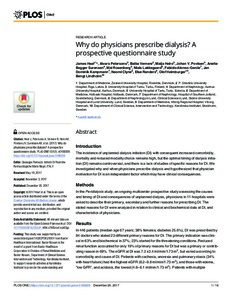Why do physicians prescribe dialysis? A prospective questionnaire study
Mai Rosenberg; Maija Heiro; James Heaf; Bengt Lindholm; Naomi Clyne; Jan Dominik Kampmann; Baiba Vernere; Fabiola Alonso-Garcia; Johan V. Povlsen; Niels Løkkegaard; Aivars Petersons; Anette Bagger Sørensen; Else Randers; Olof Heimburger
https://urn.fi/URN:NBN:fi-fe2021042718691
Tiivistelmä
Introduction
The incidence of unplanned dialysis initiation (DI) with consequent increased comorbidity, mortality and reduced modality choice remains high, but the optimal timing of dialysis initiation (DI) remains controversial, and there is a lack of studies of specific reasons for DI. We investigated why and when physicians prescribe dialysis and hypothesized that physician motivation for DI is an independent factor which may have clinical consequences.
Methods
In the Peridialysis study, an ongoing multicenter prospective study assessing the causes and timing of DI and consequences of unplanned dialysis, physicians in 11 hospitals were asked to describe their primary, secondary and further reasons for prescribing DI. The stated reasons for DI were analyzed in relation to clinical and biochemical data at DI, and characteristics of physicians.
Results
In 446 patients (median age 67 years; 38% females; diabetes 25.6%), DI was prescribed by 84 doctors who stated 23 different primary reasons for DI. The primary indication was clinical in 63% and biochemical in 37%; 23% started for life-threatening conditions. Reduced renal function accounted for only 19% of primary reasons for DI but was a primary or contributing reason in 69%. The eGFR at DI was 7.2 ±3.4 ml/min/1.73 m2, but varied according to comorbidity and cause of DI. Patients with cachexia, anorexia and pulmonary stasis (34% with heart failure) had the highest eGFR (8.2–9.8 ml/min/1.73 m2), and those with edema, “low GFR”, and acidosis, the lowest (4.6–6.1 ml/min/1.73 m2). Patients with multiple comorbidity including diabetes started at a high eGFR (8.7 ml/min/1.73 m2). Physician experience played a role in dialysis prescription. Non-specialists were more likely to prescribe dialysis for life-threatening conditions, while older and more experienced physicians were more likely to start dialysis for clinical reasons, and at a lower eGFR. Female doctors started dialysis at a higher eGFR than males (8.0 vs. 7.1 ml/min/1.73 m2).
Conclusions
DI was prescribed mainly based on clinical reasons in accordance with current recommendations while low renal function accounted for only 19% of primary reasons for DI. There are considerable differences in physicians´ stated motivations for DI, related to their age, clinical experience and interpretation of biochemical variables. These differences may be an independent factor in the clinical treatment of patients, with consequences for the risk of unplanned DI.
Kokoelmat
- Rinnakkaistallenteet [19207]
